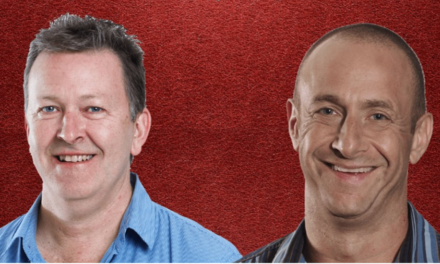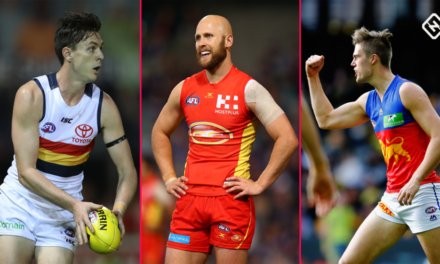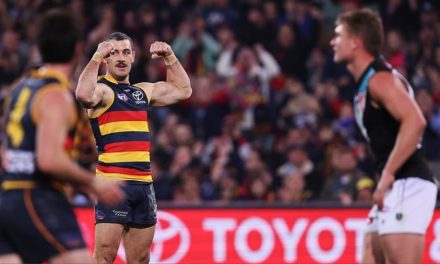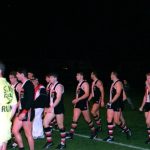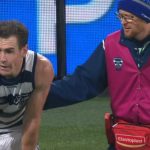Adelaide and Port Adelaide players observe a moment’s silence for victims of violence against women. Photo: AFL MEDIA
Time marches on quickly in AFL football, the relentless appetite for anything to do with the game and the churn of the news cycle rendering today’s drama tomorrow’s nostalgia piece.
In that context, perhaps it shouldn’t surprise that it’s now been exactly 12 months since Andrew Dillon was officially announced as Gillon McLachlan’s successor to the post of AFL chief executive.
The report card thus far has been very favourable from every corner of the now vast football industry, as was always likely to be the case.
Dillon’s quiet, understated manner is in obvious contrast to the flamboyance of his predecessor McLachlan, or the feistiness of another former chief executive in Andrew Demetriou. He’s happy to consult and collaborate, happier still not to be bathed in the spotlight.
Those qualities might end up proving valuable assets, too. Because there’s not just one, nor two, but several key issues surrounding the game that are quickly coming to a head under his watch, and their resolution might have ramifications far greater than most things earlier CEOs have had to deal with.
Issues like …
WOMEN
The AFL’s forays into social issues are, depending upon whom you ask, a responsible recognition of its role as an influential organisation within society, or an unnecessary distraction from what should be its most fundamental role of running a national football competition.
Surely, however, few would quibble with this weekend’s gesture of a moment’s silence at all AFL games to honour the victims of violence against women, which, at the time of writing, had claimed 36 lives in Australia already this year. The AFL on Thursday also announced a partnership with Our Watch to deliver face-to-face educational training to all AFL clubs.
The cynics, however, will be eagerly watching developments in the case of former North Melbourne player Tarryn Thomas, sacked by the Roos earlier this year and suspended by the AFL for “conduct unbecoming” after repeated allegations about his behaviour towards women, including threats of violence.
Thomas is keen to return to AFL football and has found public support from some notable figures. This week, Essendon coach Brad Scott cautiously supported his return.
Brownlow medallist Jimmy Bartel, these days a prominent and highly-regarded media commentator, however, takes a harder line. “The numbers are actually getting worse … that whole forgiveness, try again, try again (approach) is not working,” he said.
The battle lines are drawn. And again, Dillon finds himself having to be the public face of whatever decision is made in a highly-emotive issue.
It’s another example of the particularly sensitive times surrounding the still relatively-new AFL boss. Who will have to deal with very real and potentially cataclysmic realities, not just hypotheticals.
CONCUSSION
The long-term ramifications of concussion became tragically apparent in several well-documented post-football career deaths during McLachlan’s tenure as AFL chief executive. But it’s on Dillon’s watch during which the ticking timebomb might most dramatically explode.
The class action of a large group of former AFL players each seeking millions of dollars in damages is reportedly at least a year away from going to trial. The AFL has already made several significant steps in good faith to address the concussion issue as an ongoing concern.
But the heat continues to rise nonetheless, in various ways, both on and off the field. On Thursday alone, there were two examples of it.
Lawyers for former Bulldogs player Nigel Kellett, who has dementia, CTE symptoms, depression and early Parkinson’s disease neurological experts say was likely acquired during his 10-year AFL career, lashed out at the AFL in a dispute over proposed compensation.
And Hamish Brayshaw, former West Coast player and younger brother of former Demon Angus Brayshaw, who was forced into early retirement because of concussion, claimed the AFL match review and tribunal system was “single-handedly destroying the game.”
Brayshaw cited inconsistencies regarding verdicts applied to various incidents, including his brother’s famous collision with Magpie Brayden Maynard in last year’s qualifying final (for which Maynard escaped penalty), along with suspensions handed to Essendon’s Peter Wright, the Giants’ Toby Greene and Adelaide’s Matt Crouch.
“You are making it impossible to play in good spirit, you are making it impossible to adjudicate, and you’re not far off making it impossible to support,” Brayshaw said on the “Backchat” podcast. “Punish the action, not the outcome – unless the outcome is they’re OK.”
PLEASE HELP US CONTINUE TO THRIVE BY BECOMING AN OFFICIAL FOOTYOLOGY PATRON. JUST CLICK THIS LINK.
Brayshaw’s view is consistent with the growing impatience of much of the football world with inconsistencies stemming from the increased weight given to consequence rather than intent, a direct result of the AFL’s fear of not being seen to do everything within its power to tackle the concussion issue.
It is a minefield which only seems to have grown thicker. And it is Dillon who is now charged with tip-toeing through it and emerging with a game still resembling what we know, and not financially ravaged by an ocean of compensation payments.
DRUGS
Like the concussion issue, illicit drug use is another matter of concern around which the ante has been upped recently compared to the albeit uneasy agreement upon codes and practices under McLachlan as head of the AFL.
Politician Andrew Wilkie’s parliamentary allegations of serious misconduct against the AFL and clubs for effectively subverting potentially positive WADA drug testing results in late March gave new ammunition to those demanding a tighter, less welfare-driven and more interventionist approach to illicit drug use in AFL.
That has in turn prompted the highlighting of individual cases, like the tragic death of 25-year-old former Fremantle player Harley Balic, who battled addiction and mental health issues.
Balic’s father Eddie recently told News Corp: “I feel that had better support been put in place early for my son, it may have prevented this tragic outcome. The huge disappointment is that the AFL knew a lot and as a family we weren’t told. We may have saved him earlier.”
Balic’s death is the focus of a Sport Integrity Australia investigation into the AFL drug policy.
The AFL is so far continuing to hold its ground in insisting its medically-slanted policy “seeks to reduce substance use and drug-related harms for AFL players and aims to inform and rehabilitate players through education and intervention”.
But Wilkie’s revelations have added a layer of concern about integrity issues. Whilst Balic’s tragic story and others like it which will continue to come to light will increase the emotional pressure upon the AFL administration. It’s a public relations battle for Dillon from which he really cannot emerge with a “win” as such whatever the outcome.
TASMANIA
It was McLachlan who was able to lap up the pats on the back when footy heritage state Tasmania finally won AFL approval to field a team in 2028 a year ago.
But it was Dillon who was always going to be left to negotiate a way through the tangled web of Tassie politics and the league’s insistence that the Tasmania Devils were predicated on the building of a new stadium at Macquarie Point.
A month after the Tasmanian state election, Premier Jeremy Rockliff is still attempting to shore up parliamentary support to steer his government’s agenda, with some of the fiercest opposition to the proposed stadium coming from those with whom deals are necessary for the Liberal Party to remain in power.
Should the stadium concept bite the dust, would Dillon really want to be the man who became known as the guy who sunk Tasmania’s AFL team by refusing to budge on using existing facilities?
And even if the stadium is finally built, already there is speculation a timeframe of 2030 for its completion is as far more realistic timetable, forcing the Devils to play out of Blundstone Arena in Hobart and UTAS Stadium in Launceston.
Either way, the entry of the Tasmanian team is looking a lot more problematic than when McLachlan basked in the glow of what initially seemed a cut-and-dried good news story.
Unlike his predecessor, Dillon’s legacy is unlikely to be defined by the clinching of a lucrative commercial deal and the favourable optics it presents. It might instead be about the less glamorous but even more consequential matter of whether the entire code of Australian football and its biggest competition remains not only solvent, but even viable.
This article first appeared at ESPN.



